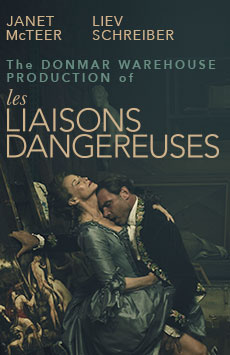When Pierre Choderlos de Laclos published his novel Les Liaisons Dangereuses in 1782, it was a scandalously sexual novel, made up entirely of letters that dealt with the theme of seduction. Now in 2016, Josie Rourke is directing an adaptation by Christopher Hampton (a transfer of the Donmar Warehouse production in the UK), playing a limited engagement at the Booth Theater. This version of the play, starring Janet McTeer and Liev Schreiber as the scheming sadistic leads, is not made up of letters, but many short scenes that take us to various drawing rooms and bedrooms. The change in the medium–from epistolary novel to stage drama–is not the only major alteration in this adaption, for somehow the entire theme and tone of the work has transformed.
On the surface, any novel from 1782 turned into a play and staged in 2016 must feel different, but Les Liaisons Dangereuses is suffering from a cultural shock more severe than the average Broadway revival of a period piece. Although the novel original explored the themes of sex, seduction, affairs, and corruption, the play seems to be about something much darker when viewed by the politically-conscious audience of today. With sexual assault scandals daily being discussed on the news (everything from Brock Turner to Donald Trump), rape is something audiences are thinking about more, they are more conscious of it, more sensitive to it.
Thus, when Valmont (Schrieber) breaks into the bedroom of the adolescent Cecile (played by the annoyingly childish Elena Kampouris), shirtless and stroking her while she sleeps, the audience becomes tense. Things only get worse when Cecile wakes up, as he quickly covers her mouth and holds her down. He blackmails her, warning that if she doesn’t grant him a kiss, he will tell her mother that he was allowed in her bedroom for a late-night rendezvous (a lie). Reluctantly, Cecile agrees to a kiss, clearly not enjoying the experience and frequently saying “no, please don’t, I don’t want to.” Valmont persists, and eventually forces her onto the bed and gets even more physical. Maybe this was amorous and seductive in 18th century France, but now it is quite clearly a rape.
There are several notable elements that make this scene even more disturbing, notably the direction, the script, and some of the audience’s reactions. In the novel, the scene is clearly a sexual assault, but in the play, the director staged the scene and directed the actors in a way that things become much more “blurred,” with Cecile even seemingly to consent in the end and even enjoy it. Oddly enough, the playwright/adapter wrote another bedroom scene for the pair, this time with Cecile running in and excitingly jumping on the bed, eager for more “sex lessons” from Valmont–something not based in the novel at all. Finally, the audience seemed split during this scene, with the younger crowd (myself included) stunned silent, shocked, and appalled. The older crowd, however, went right along with the director and laughed throughout the scene, thinking that it was comedic and believing this to be just one of Valmont’s many successful seductions.
Sitting there aghast while many audience members laughed during a rape scene, it was hard not to be offended. Sadly, the pattern repeated throughout the show, as Valmont’s character similarly coerces, pressures, and physically intimidates several other female characters, notably Tourvel (Birgitte Hjort Sorensen) and Merteuil (McTeer), until they finally “consent” to having sex with him. The most memorable occasions include Valmont’s grabbing Tourvel, pushing her against a wall, and kissing her so forcefully she begins to cry. Towards the end of the show, he screams at Merteuil, who lost a bet and in return is supposed to sleep; disgusted, she rescinds the offer. Upon being denied Valmont screams at her and demands he sleep with her or declare war. In possibly the strongest and most feminist moment of the entire work, Merteuil looks at him, stands her ground, and screams “War, then!” as she runs off the stage.
Regardless of the confusing plot, long run time, and conflicting design elements, Les Liaisons Dangereuses is a very interesting piece of theater to see, if for nothing else than to witness the changing ways in which historical works are received over time. This play may prove that Broadway audiences no longer want to sit through a three-hour play about rape simply because it was written in 1872 and the actors have British accents and wear pretty costumes.






